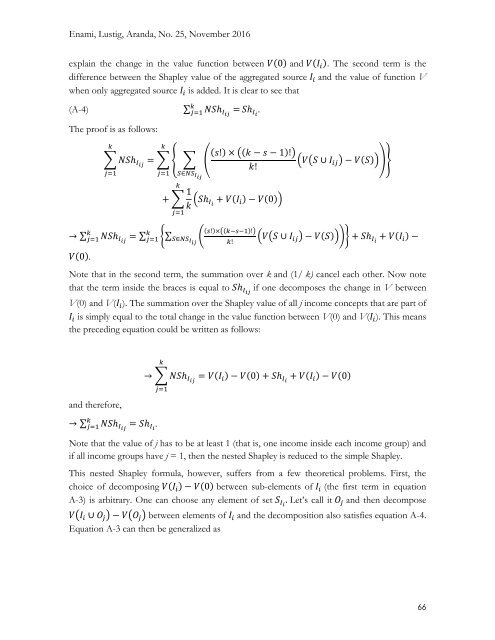IMPACT OF TAXES AND TRANSFERS
n?u=RePEc:tul:ceqwps:25&r=lam
n?u=RePEc:tul:ceqwps:25&r=lam
You also want an ePaper? Increase the reach of your titles
YUMPU automatically turns print PDFs into web optimized ePapers that Google loves.
Enami, Lustig, Aranda, No. 25, November 2016<br />
explain the change in the value function between V(0) and V(Ḭ i ). The second term is the<br />
difference between the Shapley value of the aggregated source Ḭ i and the value of function V<br />
when only aggregated source Ḭ i is added. It is clear to see that<br />
k<br />
(A-4) ∑j=1 NSh Iij = Sh Ii .<br />
The proof is as follows:<br />
k<br />
∑ NSh Iij<br />
j=1<br />
k<br />
(s!) × ((k − s − 1)!)<br />
= ∑ { ∑ ( (V(S ∪ Ḭ<br />
k!<br />
ij ) − V(S)))<br />
j=1<br />
S∈NS Iij<br />
}<br />
k<br />
+ ∑ 1 k (Sh I i<br />
+ V(Ḭ i ) − V(0))<br />
j=1<br />
k<br />
k<br />
→ ∑j=1 NSh Iij = ∑ {∑ ( (s!)×((k−s−1)!)<br />
j=1<br />
(V(S ∪ Ḭ ij ) − V(S)))<br />
V(0).<br />
S∈NS Iij<br />
}<br />
k!<br />
+ Sh Ii + V(Ḭ i ) −<br />
Note that in the second term, the summation over k and (1/ k) cancel each other. Now note<br />
that the term inside the braces is equal to Sh Iij if one decomposes the change in V between<br />
V(0) and V(Ḭ i ). The summation over the Shapley value of all j income concepts that are part of<br />
Ḭ i is simply equal to the total change in the value function between V(0) and V(Ḭ i ). This means<br />
the preceding equation could be written as follows:<br />
and therefore,<br />
k<br />
→ ∑ NSh Iij<br />
j=1<br />
= V(Ḭ i ) − V(0) + Sh Ii + V(Ḭ i ) − V(0)<br />
k<br />
→ ∑j=1 NSh Iij = Sh Ii .<br />
Note that the value of j has to be at least 1 (that is, one income inside each income group) and<br />
if all income groups have j = 1, then the nested Shapley is reduced to the simple Shapley.<br />
This nested Shapley formula, however, suffers from a few theoretical problems. First, the<br />
choice of decomposing V(Ḭ i ) − V(0) between sub-elements of Ḭ i (the first term in equation<br />
A-3) is arbitrary. One can choose any element of set S Ii . Let’s call it O j and then decompose<br />
V(Ḭ i ∪ O j ) − V(O j ) between elements of Ḭ i and the decomposition also satisfies equation A-4.<br />
Equation A-3 can then be generalized as<br />
66



